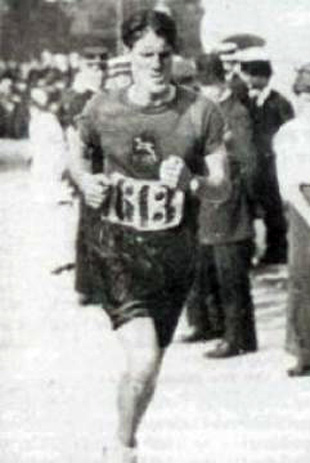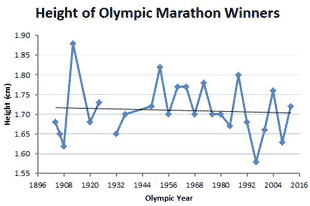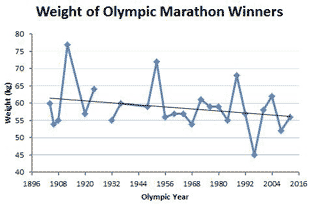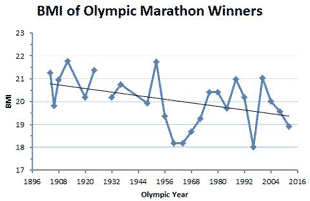The Olympic Games brings together the best athletes in the world. Studying the changes in anthropometric measurements of Olympic champions can demonstrate how athletes in general have changed over 100 years of sport. The modern elite marathoners, exemplified by the Kenyans, are of moderate height and are quite thin, in bodies built for efficient running. Looking back at the Olympic Games marathon champions, particularly before the advent of the Africans into the sport, body size varied quite markedly.
 Kenneth McArthur, the 1912 marathon champion
Kenneth McArthur, the 1912 marathon champion(Height 1.88 m / 6 ft 2 in, Weight 77 kg / 170 lb)
Anthropometric Measures of Olympic Marathoners
Here is a table of the height, weight and body mass index (BMI) of the male Olympic marathon champions for most Olympiads (a few early details are unavailable). The graphs presented below show how these measures have changed over time. Generally, there is a trend for leaner (lower BMI) athletes more recently, though the height and weight of the Olympic champion in the marathon havve fluctuated over time.
| Year | Winner | Time | Height | Weight | BMI |
|---|---|---|---|---|---|
| 1896 | Spiridon Louis (Greece) | 2:58:50 | - | - | - |
| 1900 | Michel Théato (Luxembourg) | 2:59:45 | - | - | - |
| 1904 | Thomas Hicks (USA) | 3:28:53 | 1.68 m / 5 ft 6 in | 60 kg / 132 lb | 21.3 |
| 1906 | William Sherring (Canada) | 2:51:23.6 | 1.65 m / 5 ft 5 in | 54 kg / 119 lb | 19.8 |
| 1908 | John Hayes (USA) | 2:55:18.4 | 1.62 m / 5 ft 4 in | 55 kg / 121 lb | 21.0 |
| 1912 | Kenneth McArthur (South Africa) | 2:36:54.8 | 1.88 m / 6 ft 2 in | 77 kg / 170 lb | 21.8 |
| 1920 | Hannes Kolehmainen (Finland) | 2:32:35.8 | 1.68 m / 5 ft 6 in | 57 kg / 126 lb | 20.2 |
| 1924 | Albin Stenroos (Finland) | 2:41:22.6 | 1.73 m / 5 ft 8 in | 64 kg / 141 lb | 21.4 |
| 1928 | Boughera El Ouafi (Algeria/France) | 2:32:57.0 | - | - | - |
| 1932 | Juan Carlos Zabala (Argentina) | 2:31:36.0 | 1.65 m / 5 ft 4.5 in | 55 kg / 121 lb | 20.2 |
| 1936 | Kee-Chung Sohn (Japan) | 2:29:19.2 | 1.70 m / 5 ft 7 in | 60 kg / 132 lb | 20.8 |
| 1948 | Delfo Cabrera (Argentina) | 2:34:51.6 | 1.72 m / 5 ft 7.5 in | 59 kg / 130 lb | 19.9 |
| 1952 | Emil Zátopek (Czech) | 2:23:03.2 | 1.82 m / 6 ft 0 in | 72 kg / 159 lb | 21.7 |
| 1956 | Alain Mimoun (France) | 2:25:00.0 | 1.70 m / 5 ft 7 in | 56 kg / 123 lb | 19.4 |
| 1960 | Abebe Bikila (Ethiopia) | 2:15:16.2 | 1.77 m / 5 ft 10 in | 57 kg / 126 lb | 18.2 |
| 1964 | Abebe Bikila (Ethiopia) | 2:12:11.2 | 1.77 m / 5 ft 10 in | 57 kg / 126 lb | 18.2 |
| 1968 | Mamo Wolde (Ethiopia) | 2:20:26.4 | 1.70 m / 5 ft 6.5 in | 54 kg / 119 lb | 18.7 |
| 1972 | Frank Shorter (USA) | 2:12:19.8 | 1.78 m / 5 ft 10 in | 61 kg / 134 lb | 19.3 |
| 1976 | Waldemar Cierpinski (East Germany) | 2:09:55 | 1.70 m / 5 ft 6.5 in | 59 kg / 130 lb | 20.4 |
| 1980 | Waldemar Cierpinski (East Germany) | 2:11:03 | 1.70 m / 5 ft 6.5 in | 59 kg / 130 lb | 20.4 |
| 1984 | Carlos Lopes (Portugal) | 2:09:21 | 1.67 m / 5 ft 5.5 in | 55 kg / 121 lb | 19.7 |
| 1988 | Gelindo Bordin (Italy) | 2:10:32 | 1.80 m / 5 ft 11 in | 68 kg / 150 lb | 21.0 |
| 1992 | Hwang Yeong-Jo (Korea) | 2:13:23 | 1.68 m / 5 ft 6 in | 57 kg / 126 lb | 20.2 |
| 1996 | Josia Thugwane (South Africa) | 2:12:36 | 1.58 m / 5 ft 2 in | 45 kg / 99 lb | 18.0 |
| 2000 | Gezahegne Abera (Ethiopia) | 2:10:11 | 1.66 m / 5 ft 5 in | 58 kg / 128 lb | 21.0 |
| 2004 | Stefano Baldini (Italy) | 2:10:55 | 1.76 m / 5 ft 9.5 in | 62 kg / 137 lb | 20.0 |
| 2008 | Samuel Kamau Wansiru (Kenya) | 2:06.32 | 1.63 m / 5 ft 4 in | 52 kg / 115 lb | 19.6 |
| 2012 | Stephen Kiprotich (Uganda) | 2:08:01 | 1.72 m / 5 ft 8 in | 58 kg / 123 lb | 19.6 |
| 2016 | Eliud Kipchoge (Kenya) | 2:08:44 | 1.67 m / 5 ft 6 in | 57 kg / 126 lb | 20.4 |
| 2021 | Eliud Kipchoge (Kenya) | 2:08:44 | 1.67 m / 5 ft 6 in | 52 kg / 115 lb * | 18.6 |
* the height and weight of Kipchoge was taken from his wikipedia profile, and is different to the details from 2016 taken from the official athlete database.
source: height and weight data were collected from firstly the official IOC athlete databases, then Wikipedia profiles of each athlete, and when none was available, from the sports-reference.com website.
Height changes over time
The height of the Olympic marathon champion has varied greatly over time, ranging from the 188cm (6 ft 2 in) Kenneth McArthur in 1912, to the tiny 1.58 m (5 ft 2 in) South African Josia Thugwane in 1996.

Weight changes over time
The weight of the Olympic marathon champion has generally decreased over time. The heaviest (and tallest) was Kenneth McArthur at 77 kg (170 lb) in 1912. At the other end of the scale, South African Josia Thugwane in 1996 was only 45kg (99 lbs).

BMI changes over time
The BMI of the Olympic marathon champion has generally decreased over time. The BMI reflects the ratio of weight to height, the decreasing BMI a result mostly of the tendency for more leaner athletes in recent times.

Note: This analysis is for illustrative purposes only. The data was from different sources, and may also not accurately represent their measurements at the time of their race.
Related Research
- Marc A1, Sedeaud A, Guillaume M, Rizk M, Schipman J, Antero-Jacquemin J, Haida A, Berthelot G, Toussaint JF., Marathon progress: demography, morphology and environment. J Sports Sci. 2014;32(6):524-32. doi: 10.1080/02640414.2013.835436. Epub 2013 Nov 5.
- Khosla, T. (1985). Age, height and weight of female Olympic finalists in running events. British Journal of Sports Medicine, 19(4), 214–216.
Related Pages
- Anthropometry of Olympic Athletes
- See a similar analysis of Olympic 100m champions
- Marathon Olympic Games winners list, and world record holders
- Major marathon races around the world
- Athlete Body Size Changes Over Time
- The History of Nutrition and the Olympic Marathon
- About BMI
- Sport Specific Anthropometry, including Athletics Anthropometry
- Science and the Olympics
- Olympics Anthropology Days


 Current Events
Current Events